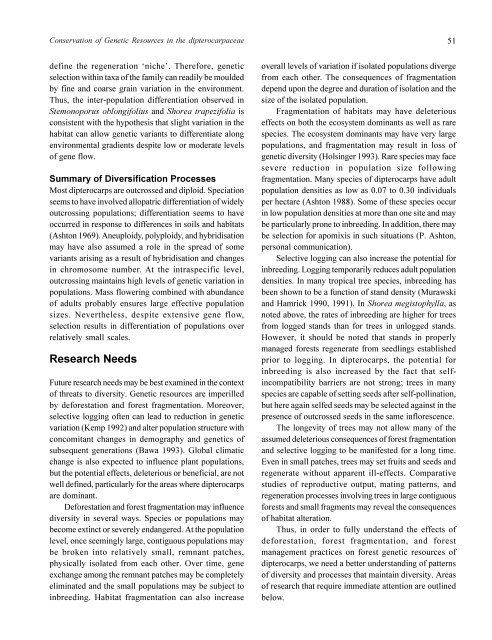A review of dipterocarps - Center for International Forestry Research
A review of dipterocarps - Center for International Forestry Research
A review of dipterocarps - Center for International Forestry Research
You also want an ePaper? Increase the reach of your titles
YUMPU automatically turns print PDFs into web optimized ePapers that Google loves.
Conservation <strong>of</strong> Genetic Resources in the dipterocarpaceae 51<br />
define the regeneration ‘niche’. There<strong>for</strong>e, genetic<br />
selection within taxa <strong>of</strong> the family can readily be moulded<br />
by fine and coarse grain variation in the environment.<br />
Thus, the inter-population differentiation observed in<br />
Stemonoporus oblongifolius and Shorea trapezifolia is<br />
consistent with the hypothesis that slight variation in the<br />
habitat can allow genetic variants to differentiate along<br />
environmental gradients despite low or moderate levels<br />
<strong>of</strong> gene flow.<br />
Summary <strong>of</strong> Diversification Processes<br />
Most <strong>dipterocarps</strong> are outcrossed and diploid. Speciation<br />
seems to have involved allopatric differentiation <strong>of</strong> widely<br />
outcrossing populations; differentiation seems to have<br />
occurred in response to differences in soils and habitats<br />
(Ashton 1969). Aneuploidy, polyploidy, and hybridisation<br />
may have also assumed a role in the spread <strong>of</strong> some<br />
variants arising as a result <strong>of</strong> hybridisation and changes<br />
in chromosome number. At the intraspecific level,<br />
outcrossing maintains high levels <strong>of</strong> genetic variation in<br />
populations. Mass flowering combined with abundance<br />
<strong>of</strong> adults probably ensures large effective population<br />
sizes. Nevertheless, despite extensive gene flow,<br />
selection results in differentiation <strong>of</strong> populations over<br />
relatively small scales.<br />
<strong>Research</strong> Needs<br />
Future research needs may be best examined in the context<br />
<strong>of</strong> threats to diversity. Genetic resources are imperilled<br />
by de<strong>for</strong>estation and <strong>for</strong>est fragmentation. Moreover,<br />
selective logging <strong>of</strong>ten can lead to reduction in genetic<br />
variation (Kemp 1992) and alter population structure with<br />
concomitant changes in demography and genetics <strong>of</strong><br />
subsequent generations (Bawa 1993). Global climatic<br />
change is also expected to influence plant populations,<br />
but the potential effects, deleterious or beneficial, are not<br />
well defined, particularly <strong>for</strong> the areas where <strong>dipterocarps</strong><br />
are dominant.<br />
De<strong>for</strong>estation and <strong>for</strong>est fragmentation may influence<br />
diversity in several ways. Species or populations may<br />
become extinct or severely endangered. At the population<br />
level, once seemingly large, contiguous populations may<br />
be broken into relatively small, remnant patches,<br />
physically isolated from each other. Over time, gene<br />
exchange among the remnant patches may be completely<br />
eliminated and the small populations may be subject to<br />
inbreeding. Habitat fragmentation can also increase<br />
overall levels <strong>of</strong> variation if isolated populations diverge<br />
from each other. The consequences <strong>of</strong> fragmentation<br />
depend upon the degree and duration <strong>of</strong> isolation and the<br />
size <strong>of</strong> the isolated population.<br />
Fragmentation <strong>of</strong> habitats may have deleterious<br />
effects on both the ecosystem dominants as well as rare<br />
species. The ecosystem dominants may have very large<br />
populations, and fragmentation may result in loss <strong>of</strong><br />
genetic diversity (Holsinger 1993). Rare species may face<br />
severe reduction in population size following<br />
fragmentation. Many species <strong>of</strong> <strong>dipterocarps</strong> have adult<br />
population densities as low as 0.07 to 0.30 individuals<br />
per hectare (Ashton 1988). Some <strong>of</strong> these species occur<br />
in low population densities at more than one site and may<br />
be particularly prone to inbreeding. In addition, there may<br />
be selection <strong>for</strong> apomixis in such situations (P. Ashton,<br />
personal communication).<br />
Selective logging can also increase the potential <strong>for</strong><br />
inbreeding. Logging temporarily reduces adult population<br />
densities. In many tropical tree species, inbreeding has<br />
been shown to be a function <strong>of</strong> stand density (Murawski<br />
and Hamrick 1990, 1991). In Shorea megistophylla, as<br />
noted above, the rates <strong>of</strong> inbreeding are higher <strong>for</strong> trees<br />
from logged stands than <strong>for</strong> trees in unlogged stands.<br />
However, it should be noted that stands in properly<br />
managed <strong>for</strong>ests regenerate from seedlings established<br />
prior to logging. In <strong>dipterocarps</strong>, the potential <strong>for</strong><br />
inbreeding is also increased by the fact that selfincompatibility<br />
barriers are not strong; trees in many<br />
species are capable <strong>of</strong> setting seeds after self-pollination,<br />
but here again selfed seeds may be selected against in the<br />
presence <strong>of</strong> outcrossed seeds in the same inflorescence.<br />
The longevity <strong>of</strong> trees may not allow many <strong>of</strong> the<br />
assumed deleterious consequences <strong>of</strong> <strong>for</strong>est fragmentation<br />
and selective logging to be manifested <strong>for</strong> a long time.<br />
Even in small patches, trees may set fruits and seeds and<br />
regenerate without apparent ill-effects. Comparative<br />
studies <strong>of</strong> reproductive output, mating patterns, and<br />
regeneration processes involving trees in large contiguous<br />
<strong>for</strong>ests and small fragments may reveal the consequences<br />
<strong>of</strong> habitat alteration.<br />
Thus, in order to fully understand the effects <strong>of</strong><br />
de<strong>for</strong>estation, <strong>for</strong>est fragmentation, and <strong>for</strong>est<br />
management practices on <strong>for</strong>est genetic resources <strong>of</strong><br />
<strong>dipterocarps</strong>, we need a better understanding <strong>of</strong> patterns<br />
<strong>of</strong> diversity and processes that maintain diversity. Areas<br />
<strong>of</strong> research that require immediate attention are outlined<br />
below.

















